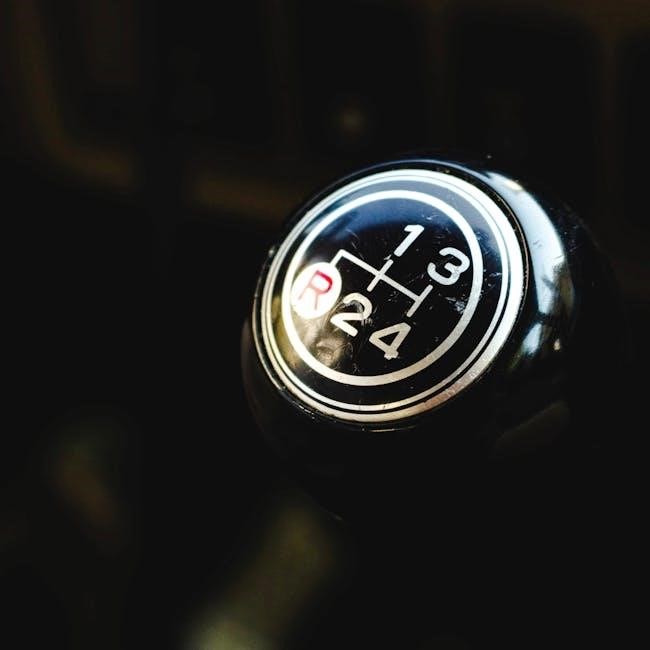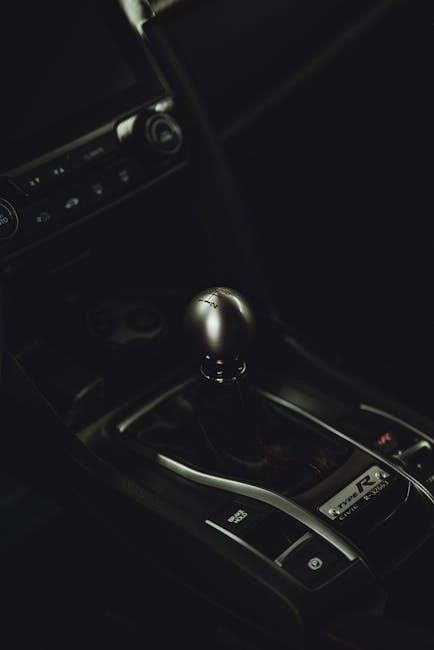
3 speed manual transmission
3 Speed Manual Transmission: An Overview
The 3-speed manual transmission, once a common sight, represents a simpler era of automotive engineering. These transmissions, characterized by three forward gears, offered drivers a direct connection to the engine. They prioritize durability and ease of maintenance over advanced performance features found in modern vehicles.

What is a 3 Speed Manual Transmission?
A 3-speed manual transmission is a type of gearbox that provides three forward gear ratios and usually one reverse gear, all controlled manually by the driver. This design contrasts with automatic transmissions, which shift gears automatically based on speed and load. In a 3-speed manual, the driver must depress the clutch pedal and move the gear lever to select the appropriate gear.
The simplicity of the 3-speed manual lies in its fewer moving parts compared to transmissions with more gears. This generally translates to increased reliability and easier maintenance. The driver directly controls the gear selection, offering a more engaging and connected driving experience. It uses gear oil or engine oil, in most cases, for lubrication.
Typically found in older vehicles, the 3-speed manual was a standard offering before the advent of more complex and efficient multi-gear transmissions. This type of transmission necessitates a deliberate driving technique, requiring drivers to carefully match engine speed with vehicle speed for smooth gear changes.

Advantages of 3 Speed Manual Transmissions
3-speed manuals offer simplicity, potentially better lifetime, and encourage the use of the parking brake. Manual cars are usually easier to maintain. Drivers also have complete control over drivetrain operation, with no electronic assistance affecting gear selection.
Fuel Efficiency
Fuel efficiency is often cited as a key advantage of 3-speed manual transmissions, stemming from their mechanical simplicity and direct connection between the engine and wheels. Typically, manual transmissions, especially those with fewer gears, demonstrate a 3-4 miles-per-gallon advantage compared to their automatic counterparts. This benefit arises because manual transmissions avoid the energy losses associated with the torque converters found in automatics.
The direct mechanical linkage minimizes slippage and maximizes the transfer of power, translating into less wasted energy and improved fuel economy. Furthermore, the driver’s ability to select the optimal gear for a given speed and load allows for precise control over engine RPMs, keeping it within the most efficient operating range.
However, it’s crucial to acknowledge that the actual fuel efficiency achieved depends heavily on driving habits. Skilled drivers who master the art of shifting at the right moments can extract the maximum fuel savings from a 3-speed manual transmission. Conversely, aggressive driving or improper gear selection can negate these potential benefits.
Simplicity and Maintenance
The inherent simplicity of 3-speed manual transmissions translates directly into easier and less frequent maintenance, making them a cost-effective option in the long run. With fewer moving parts compared to automatic transmissions or even manuals with more gears, there are fewer components that can break down or require attention. This reduced complexity contributes to a longer lifespan and enhanced reliability.
Manual transmissions generally use gear oil or engine oil for lubrication, which is straightforward to check and replace. The absence of intricate hydraulic systems and electronic controls simplifies troubleshooting and repair procedures. Manual transmission cars are usually easier to maintain than their automatic counterparts.
Moreover, the robust design of 3-speed manuals makes them more tolerant of harsh conditions and less susceptible to damage from overheating or contamination. This durability is particularly advantageous in older vehicles or those subjected to heavy use.
However, like any mechanical system, regular maintenance is still essential. Changing the gear oil at recommended intervals and addressing any signs of wear or damage promptly can ensure optimal performance and longevity.
Driver Control
One of the primary advantages of a 3-speed manual transmission lies in the enhanced level of driver control it offers over the vehicle’s performance. Unlike automatic transmissions that autonomously shift gears based on speed and load, a manual transmission puts the driver firmly in command of gear selection, allowing for precise matching of engine output to driving conditions.
This direct connection provides a more engaging and interactive driving experience. Drivers can select the optimal gear for acceleration, deceleration, or maintaining speed on varying terrain. This level of control is especially beneficial in situations where precise throttle and gear management are crucial, such as towing, off-roading, or navigating challenging road conditions.
Moreover, the ability to downshift for engine braking provides additional control during deceleration and can reduce wear on the vehicle’s brakes. A manual transmission gives complete control over the drivetrain operation, without electronic intervention. The driver can operate the transmission in various scenarios, adapting to different driving needs and preferences.
The driver is able to fully control braking without a torque converter. This allows the driver to have complete control over the car;
Disadvantages of 3 Speed Manual Transmissions
While offering simplicity, 3-speed manual transmissions have drawbacks. These include a steeper learning curve for new drivers, reduced efficiency at higher speeds, and potential for gearbox damage if not operated correctly, leading to clutch wear. Modern transmissions offer more gears for optimal performance.
Learning Curve
Mastering a 3-speed manual transmission involves a unique learning curve. Unlike automatic transmissions, drivers must coordinate the clutch, gear lever, and throttle. This requires practice and coordination to avoid stalling, jerking, or grinding gears, especially for beginners accustomed to the ease of automatics.
The initial challenge lies in understanding the relationship between engine speed and gear selection. Knowing when to shift up or down requires developing a feel for the engine’s power band and listening to its sound. Smooth transitions between gears demand precise clutch control and throttle modulation.
Furthermore, mastering hill starts with a 3-speed manual can be particularly daunting. Drivers must prevent the car from rolling backward while simultaneously engaging the clutch and applying the throttle. This requires quick reflexes and a good sense of balance.
While modern manual transmissions with more gears can offer a smoother experience, the fundamental principles remain the same. Overcoming the learning curve of a 3-speed manual transmission builds a solid foundation for understanding manual gearboxes in general, improving overall driving skills and vehicle control.
However, with persistence and practice, drivers can overcome these challenges and enjoy the engaging experience of driving a vehicle with a 3-speed manual transmission.
Reduced Efficiency in Certain Situations
While 3-speed manual transmissions can offer fuel efficiency in certain conditions, they often exhibit reduced efficiency compared to modern transmissions, particularly in specific driving scenarios. The limited number of gears means the engine may not always operate at its optimal RPM range, leading to wasted fuel.
For instance, during highway driving, the lack of an overdrive gear can force the engine to run at higher RPMs, consuming more fuel than necessary. Similarly, in stop-and-go traffic, frequent gear changes and clutch engagement can also decrease fuel economy. The driver must constantly shift to keep the engine in its power band, which is not always efficient.
Furthermore, the wider gear ratios in a 3-speed transmission can result in less precise speed control, making it more challenging to maintain a consistent speed, especially on hilly terrain. This lack of precision can also lead to increased fuel consumption. Modern transmissions, with their closer gear ratios, offer a more refined driving experience and better fuel efficiency.
In situations requiring rapid acceleration, the limited gear options may also hinder performance. The engine may struggle to find the optimal gear for delivering maximum power, resulting in slower acceleration and reduced overall efficiency, especially when compared to vehicles equipped with more advanced transmissions.
Gearbox Damage and Clutch Wear
Operating a 3-speed manual transmission requires a certain level of skill and attention, as improper technique can lead to gearbox damage and accelerated clutch wear. Unlike modern transmissions, which often feature synchronizers to ease gear engagement, older 3-speeds may demand more precise clutch and throttle coordination.
One common issue is “grinding gears,” which occurs when attempting to shift without fully disengaging the clutch or when shifting too quickly. This grinding can damage the gear teeth over time, leading to costly repairs. Similarly, “dumping” the clutch—releasing it too abruptly—can shock the drivetrain and cause excessive wear on the clutch disc and pressure plate.
Moreover, frequent stop-and-go traffic can put a strain on the clutch, as drivers constantly engage and disengage it. This repeated use can lead to premature wear and eventual clutch failure. Poor driving habits, such as resting the foot on the clutch pedal while driving, can also contribute to accelerated wear.
Maintaining proper lubrication is crucial for the longevity of the gearbox. Low or contaminated gear oil can increase friction and heat, leading to damage to the gears and bearings. Regular inspection and replacement of the gear oil are essential for preventing these issues and ensuring smooth operation of the transmission.

3 Speed vs. Automatic Transmissions
The debate between 3-speed manual and automatic transmissions highlights fundamental differences in driving experience and mechanical complexity. 3-speed manuals, prevalent in older vehicles, offer direct driver control. The driver is responsible for selecting the appropriate gear for the driving conditions. This engagement provides a sense of connection with the vehicle, favored by enthusiasts who appreciate the art of shifting.
Automatic transmissions, conversely, prioritize convenience. They automatically shift gears based on speed and throttle input, reducing driver workload. This is particularly advantageous in city driving, where frequent stops and starts require constant gear changes. However, this convenience comes at the cost of reduced driver involvement.
From a mechanical standpoint, 3-speed manuals are simpler. They have fewer moving parts, making them generally easier to maintain and repair. Automatic transmissions, with their intricate hydraulic systems and complex gearsets, are more prone to failures and can be more expensive to service. Moreover, manual transmissions typically offer better fuel efficiency due to the direct mechanical connection between the engine and wheels, avoiding the energy losses inherent in automatic transmissions’ torque converters.
However, modern automatic transmissions have narrowed the gap in fuel efficiency and performance. They often feature more gears and sophisticated electronic controls, providing smoother shifts and optimized power delivery, making them appealing to a broader range of drivers.

Column Shift (“3 on the Tree”)
The “3 on the Tree,” or column shift, represents a unique configuration of the 3-speed manual transmission. Instead of a floor-mounted shifter, the gear lever is located on the steering column. This design was common in American cars from the 1940s to the 1970s, offering a spacious front cabin by eliminating the floor shifter. The “3 on the Tree” required a specific skill set to operate smoothly. Drivers needed to master the coordination of the clutch pedal with the column-mounted shifter.
While offering a clean and open front seating area, the column shift had its drawbacks. The linkage between the steering column and the transmission was often complex and prone to wear, leading to sloppy shifting. Finding the correct gear could be challenging, particularly in hurried situations. Despite these challenges, the “3 on the Tree” holds a nostalgic appeal for many car enthusiasts. It symbolizes a distinct era in automotive design when practicality and spaciousness were highly valued.
Furthermore, the column shift allowed for bench seats, comfortably accommodating more passengers in the front. This configuration contributed to the classic American driving experience, emphasizing comfort and sociability. Though less common today, the “3 on the Tree” remains a memorable and historically significant aspect of automotive history, reminding us of a time when driving was a more tactile and engaging experience.